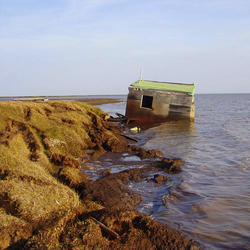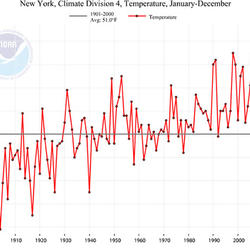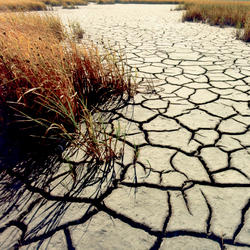Tom Loveland talks about using Landsat's data for land use and land cover change research.
Find this video and thousands more at https://usgs.gov/gallery.
How do changes in climate and land use relate to one another?
The link between land use and the climate is complex. First, land cover--as shaped by land use practices--affects the global concentration of greenhouse gases. Second, while land use change is an important driver of climate change, a changing climate can lead to changes in land use and land cover. For example, farmers might shift from their customary crops to crops that will have higher economic return under changing climatic conditions. Higher temperatures affect mountain snowpack and vegetation cover as well as water needed for irrigation. The understanding of the interactions between climate and land use change is improving but continued scientific investigation is needed.
Related Content
Does an increase in the 100-year flood estimate originate from climate or land-use change?
Climate variability (dry cycles to wet cycles) and land-use change play a significant role, but there is a large amount of uncertainty around the flood quantile estimates (the value of discharge corresponding to the 100-year flood), particularly if there isn’t a long record of observed data at a stream location. Learn more: The 100-Year Flood The 100-Year Flood--It's All About Chance
What are the long-term effects of climate change?
Scientists have predicted that long-term effects of climate change will include a decrease in sea ice and an increase in permafrost thawing, an increase in heat waves and heavy precipitation, and decreased water resources in semi-arid regions. Below are some of the regional impacts of global change forecast by the Intergovernmental Panel on Climate Change: North America: Decreasing snowpack in the...
What is the difference between weather and climate change?
Weather refers to short term atmospheric conditions while climate is the weather of a specific region averaged over a long period of time. Climate change refers to long-term changes.
How can climate change affect natural disasters?
With increasing global surface temperatures the possibility of more droughts and increased intensity of storms will likely occur. As more water vapor is evaporated into the atmosphere it becomes fuel for more powerful storms to develop. More heat in the atmosphere and warmer ocean surface temperatures can lead to increased wind speeds in tropical storms. Rising sea levels expose higher locations...
How do we know the climate is changing?
The scientific community is certain that the Earth's climate is changing because of the trends that we see in the instrumented climate record and the changes that have been observed in physical and biological systems. The instrumental record of climate change is derived from thousands of temperature and precipitation recording stations around the world. We have very high confidence in these...
What are some of the signs of climate change?
• Temperatures are rising world-wide due to greenhouse gases trapping more heat in the atmosphere. • Droughts are becoming longer and more extreme around the world. • Tropical storms becoming more severe due to warmer ocean water temperatures. • As temperatures rise there is less snowpack in mountain ranges and polar areas and the snow melts faster. • Overall, glaciers are melting at a faster rate...
What is the difference between global warming and climate change?
Although people tend to use these terms interchangeably, global warming is just one aspect of climate change. “Global warming” refers to the rise in global temperatures due mainly to the increasing concentrations of greenhouse gases in the atmosphere. “Climate change” refers to the increasing changes in the measures of climate over a long period of time – including precipitation, temperature, and...
Why is climate change happening and what are the causes?
There are many “natural” and “anthropogenic” (human-induced) factors that contribute to climate change. Climate change has always happened on Earth, which is clearly seen in the geological record; it is the rapid rate and the magnitude of climate change occurring now that is of great concern worldwide. Greenhouse gases in the atmosphere absorb heat radiation. Human activity has increased...
 Landsat in Action - Land Cover and Land Cover Change with Tom Loveland
Landsat in Action - Land Cover and Land Cover Change with Tom Loveland
Tom Loveland talks about using Landsat's data for land use and land cover change research.
Find this video and thousands more at https://usgs.gov/gallery.
 A Record of Change: Science and Elder Observations on the Navajo N.
A Record of Change: Science and Elder Observations on the Navajo N.
A Record of Change—Science and Elder Observations on the Navajo Nation is a 25-minute documentary about collaborative studies using conventional physical sciences, combined with tribal elder observations to show that local knowledge and conventional science partnerships can effectively document ecosystem change and determine the resulting challenges to livelihoods.&
A Record of Change—Science and Elder Observations on the Navajo Nation is a 25-minute documentary about collaborative studies using conventional physical sciences, combined with tribal elder observations to show that local knowledge and conventional science partnerships can effectively document ecosystem change and determine the resulting challenges to livelihoods.&
 PubTalk 10/2015 — Fire-climate Relationships in the Sierra Nevada
PubTalk 10/2015 — Fire-climate Relationships in the Sierra Nevada
Surprises relevant to future fire regime forecasts
by Jon E. Keeley, USGS Research Scientist
Surprises relevant to future fire regime forecasts
by Jon E. Keeley, USGS Research Scientist
 PubTalk 3/2012 — Projected Climate Change Impacts in California
PubTalk 3/2012 — Projected Climate Change Impacts in California
--the consequences of increasing atmospheric greenhouse gases
Tom Suchanek, USGS Western Ecological Research Center Lead Scientist and Climate Change Coordinator
--the consequences of increasing atmospheric greenhouse gases
Tom Suchanek, USGS Western Ecological Research Center Lead Scientist and Climate Change Coordinator
Monitoring and assessing urban heat island variations and effects in the United States
Using information from global climate models to inform policymaking—The role of the U.S. Geological Survey
Simulation of water availability in the Southeastern United States for historical and potential future climate and land-cover conditions
A record of change - Science and elder observations on the Navajo Nation
Ecosystem vulnerability to climate change in the southeastern United States
Climate Change Science Activities of the U.S. Geological Survey in New England
Desert wetlands—Archives of a wetter past
USGS Arctic Science Strategy
Climate change: evaluating your local and regional water resources
Remote sensing of land surface phenology
Delivering climate science about the Nation's fish, wildlife, and ecosystems: the U.S. Geological Survey National Climate Change and Wildlife Science Center
U.S. Geological Survey Climate and Land Use Change Science Strategy—A Framework for Understanding and Responding to Global Change
Related Content
Does an increase in the 100-year flood estimate originate from climate or land-use change?
Climate variability (dry cycles to wet cycles) and land-use change play a significant role, but there is a large amount of uncertainty around the flood quantile estimates (the value of discharge corresponding to the 100-year flood), particularly if there isn’t a long record of observed data at a stream location. Learn more: The 100-Year Flood The 100-Year Flood--It's All About Chance
What are the long-term effects of climate change?
Scientists have predicted that long-term effects of climate change will include a decrease in sea ice and an increase in permafrost thawing, an increase in heat waves and heavy precipitation, and decreased water resources in semi-arid regions. Below are some of the regional impacts of global change forecast by the Intergovernmental Panel on Climate Change: North America: Decreasing snowpack in the...
What is the difference between weather and climate change?
Weather refers to short term atmospheric conditions while climate is the weather of a specific region averaged over a long period of time. Climate change refers to long-term changes.
How can climate change affect natural disasters?
With increasing global surface temperatures the possibility of more droughts and increased intensity of storms will likely occur. As more water vapor is evaporated into the atmosphere it becomes fuel for more powerful storms to develop. More heat in the atmosphere and warmer ocean surface temperatures can lead to increased wind speeds in tropical storms. Rising sea levels expose higher locations...
How do we know the climate is changing?
The scientific community is certain that the Earth's climate is changing because of the trends that we see in the instrumented climate record and the changes that have been observed in physical and biological systems. The instrumental record of climate change is derived from thousands of temperature and precipitation recording stations around the world. We have very high confidence in these...
What are some of the signs of climate change?
• Temperatures are rising world-wide due to greenhouse gases trapping more heat in the atmosphere. • Droughts are becoming longer and more extreme around the world. • Tropical storms becoming more severe due to warmer ocean water temperatures. • As temperatures rise there is less snowpack in mountain ranges and polar areas and the snow melts faster. • Overall, glaciers are melting at a faster rate...
What is the difference between global warming and climate change?
Although people tend to use these terms interchangeably, global warming is just one aspect of climate change. “Global warming” refers to the rise in global temperatures due mainly to the increasing concentrations of greenhouse gases in the atmosphere. “Climate change” refers to the increasing changes in the measures of climate over a long period of time – including precipitation, temperature, and...
Why is climate change happening and what are the causes?
There are many “natural” and “anthropogenic” (human-induced) factors that contribute to climate change. Climate change has always happened on Earth, which is clearly seen in the geological record; it is the rapid rate and the magnitude of climate change occurring now that is of great concern worldwide. Greenhouse gases in the atmosphere absorb heat radiation. Human activity has increased...
 Landsat in Action - Land Cover and Land Cover Change with Tom Loveland
Landsat in Action - Land Cover and Land Cover Change with Tom Loveland
Tom Loveland talks about using Landsat's data for land use and land cover change research.
Find this video and thousands more at https://usgs.gov/gallery.
Tom Loveland talks about using Landsat's data for land use and land cover change research.
Find this video and thousands more at https://usgs.gov/gallery.
 A Record of Change: Science and Elder Observations on the Navajo N.
A Record of Change: Science and Elder Observations on the Navajo N.
A Record of Change—Science and Elder Observations on the Navajo Nation is a 25-minute documentary about collaborative studies using conventional physical sciences, combined with tribal elder observations to show that local knowledge and conventional science partnerships can effectively document ecosystem change and determine the resulting challenges to livelihoods.&
A Record of Change—Science and Elder Observations on the Navajo Nation is a 25-minute documentary about collaborative studies using conventional physical sciences, combined with tribal elder observations to show that local knowledge and conventional science partnerships can effectively document ecosystem change and determine the resulting challenges to livelihoods.&
 PubTalk 10/2015 — Fire-climate Relationships in the Sierra Nevada
PubTalk 10/2015 — Fire-climate Relationships in the Sierra Nevada
Surprises relevant to future fire regime forecasts
by Jon E. Keeley, USGS Research Scientist
Surprises relevant to future fire regime forecasts
by Jon E. Keeley, USGS Research Scientist
 PubTalk 3/2012 — Projected Climate Change Impacts in California
PubTalk 3/2012 — Projected Climate Change Impacts in California
--the consequences of increasing atmospheric greenhouse gases
Tom Suchanek, USGS Western Ecological Research Center Lead Scientist and Climate Change Coordinator
--the consequences of increasing atmospheric greenhouse gases
Tom Suchanek, USGS Western Ecological Research Center Lead Scientist and Climate Change Coordinator









